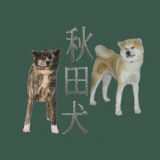The AKITA dog, origin and development
Akita the Origin
The Akita Inu is the Japanese national dog.
Origins of the breed can be traced back to the 15th century. Skeletal remains can be traced back even further. Similar-looking dogs must have been in existence in Japan up to 5000 years ago. The name Akita is taken from the Japanese prefecture in the northern part of Honshu. Here is the most likely birthplace of the breed. The second name “Inu” or “Ken” means nothing more than “dog”. During the Tokugawa and Taisho epochs (1603-1925) the Akita was thought to be the companion of the Samurai.
In 1931 Emperor Hirohito declared the Akita a national treasure, and further export was prohibited. This edict was followed until post-1945. During the Second World War many Akitas were sold to America. To this day the Akita is the embodiment of undying devotion in Japan. At Shibuya railway station in Tokyo there is a bronze statue of the Akita “Hachiko”, which reminds passers-by of this particular Akita’s devotion to his master. Hachiko was the dog of a Tokyo university professor, and accompanied his master to the station every morning, meeting him there again in the afternoon. Professor Ueno died in 1925 of a heart attack, but Hachiko maintained his ritual, going to the station every morning and evening for a staggering 10 years. Hachiko was found dead on 7th March, 1935, on the very spot where he habitually waited for his master.
Personality of the Akita
The Akita is an extremely intelligent breed, demonstrating nobility and dignity. Once you have owned an Akita, you will come to learn the many facets of his personality. The breed is absolutely loyal to family, is loving and obedient.
He is calm, well-balanced, brave, and extremely protective. Two things, however, must be borne in mind: you must never try to force him to do something, and he will not tolerate larger dogs who will not yield to him.

Prerequisites for owning an Akita
The Akita is very hard to provoke, and as such is not suited as a security dog.
These days, the breed is mainly kept as a family pet, as companion, or domestic guard dog. Although they are not easy to train, the Akita is a very versatile breed. They have been used variously as hunting dogs, guide dogs for the blind (“seeing-eye” dogs), rescue dogs, and working animals.
Even today, the breed is used on Hokkaido as a working and hunting dog. His hunting credits include fowl as well as larger game, including bears. He has even been used occasionally as a sled dog, although his gentle nature and dominant character distinguish him from other sled breeds.
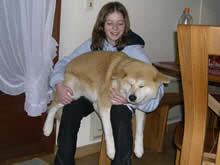
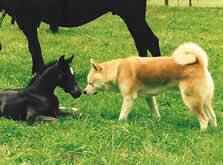

Physique and colour of coat
The Akita is a large, well-proportioned, robustly built breed. His distinguishing features are his rather small, stiff, slightly forward-pointing ears, curled tail, and calm demeanour. His coat is rather wiry, but with a thick, soft undercoat. The colours officially recognized in Japan, as well as by FCI-conforming countries are red with a light muzzle, brindle with a light muzzle, and white.


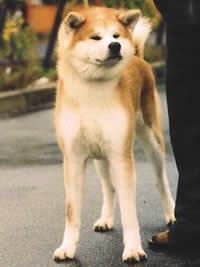
Moulting of the Akita
in general, moulting occurs twice a year, and is extensive. With intensive brushing during this period, however, this is soon forgotten. During this time, clumps of hair can accumulate in the house, but this can easily be tidied away by hand. Apart from this, the Akita coat does not need a lot of care
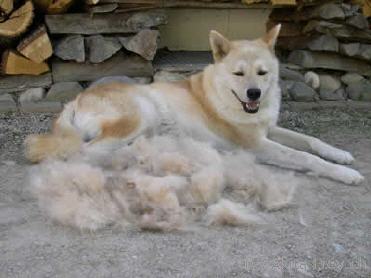
In our experience, the Akita’s fur can easily be removed from clothing by rolling a ball of hair over the affected area. The hair is then easily removed, in comparison to short haired breeds, whose hair sticks to clothing and can only be removed by tiresome plucking.
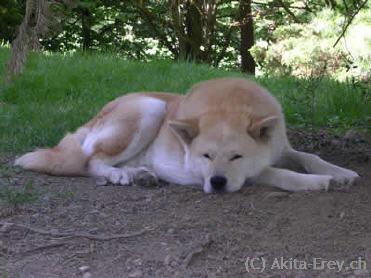
The Akita is also very pleasant when wet, giving off almost no odour, unlike our German Shepherd! Dirt falls out of the coat on its own when dry. Our dog is now 8 years old, and has only been seriously bathed twice, for important shows. On both occasions this was a far from straightforward endeavour, even with a whole bottle of shampoo we didn’t manage to get him even half way wet and soapy! The undercoat of the Akita is extremely dense, which makes it nearly impossible to wet through to the skin.
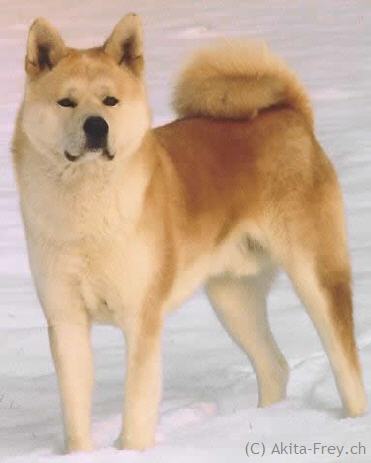
Temper of the Akita
Looking at the origin and use of the Akita in his home land it springs to mind that this breed naturally thinks independently and acts with courage. When, for example, he faces a bear during a hunt, he must act fast, independently and with courage without having to wait for instructions from his master. Do not be deceived by the Akita’s somewhat phlegmatic appearance, if necessary he can transform from a duck into a Ferrari within seconds.
The Akita is very human-oriented and loves his family above everything. However, he enjoys his peace when there are many visitors present. If not left alone when he chooses so, then it’s possible that he might snap. But, as always the personalities can vary. Our male Akita, for example, prefers his peace, whereas two of our bitches cannot get enough affection from us and our other two bitches are of rather neutral behaviour.
If you’re used to a German Shepherd then an Akita’s personality differs quite a bit from it.
With an Akita you always have the impression to be in a slow-motion movie. When, for example we want to demonstrate the command “sit” in front of some visitors, then they regularly break out in laughter.
If you are under time pressure to get from point A to B, then often you seem unable to hurry the Akita. The dog seems to sense the stress, therefore keeps more distance between him and his master and impossible to hurry up. Only when the master relaxes the Akita does too.
Acqiring and training an Akita
if you think of buying an Akita, the following points should be observed.
- Generally you’re bound to be crazy about the Akita (no matter if you`re seen a photo, read about the breed in a book or seen one). Once bitten by the Akita virus, it`s hard to shake it off.
- You need to have a lot of love, patience and above all a stronger will than the Akita.
- Training needs to be consistent, otherwise the Akita will find it difficult to obey. For example: if the Akita isn’t allowed to jump onto the sofa then this rule should apply at all times. By sticking to the rules you make sure that you are the master and not your dog.
- You can accept that your Akita may not get on with every other dog and that he won’t accept the lead in an open field.
If you can accept the above points then the Akita could be your future friend and comparion. Allow yourself enough time to find the right puppy and then you won`t wont to wait to spend time with your new dog. I wish you a lot of luck, fun and love with your Akita.

